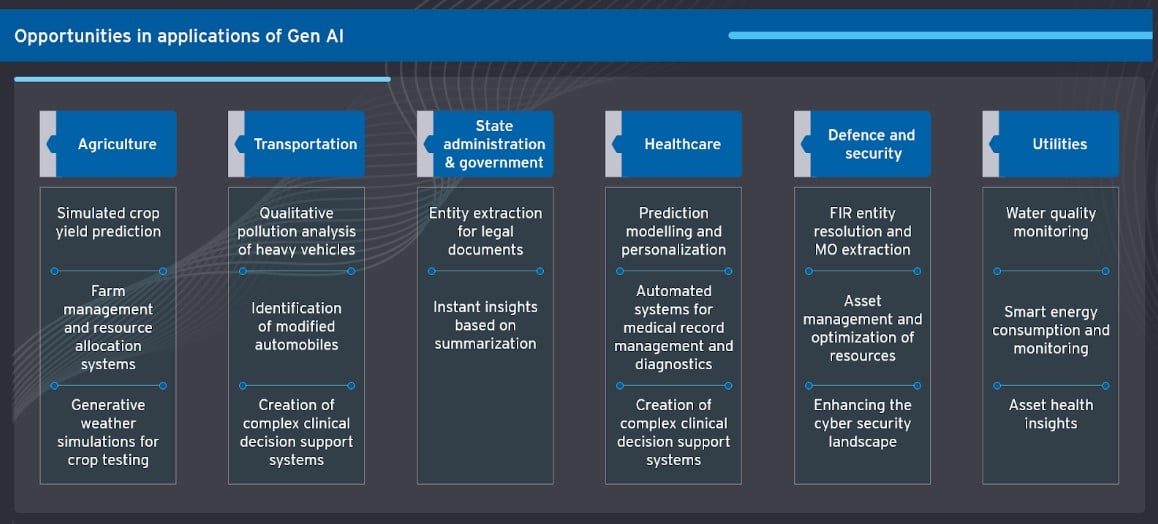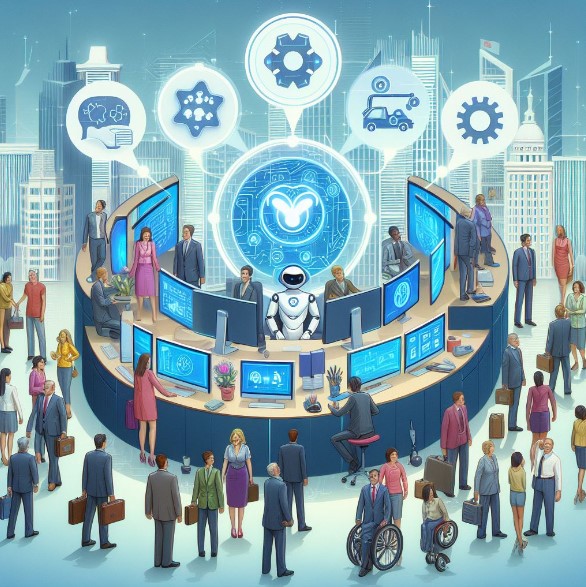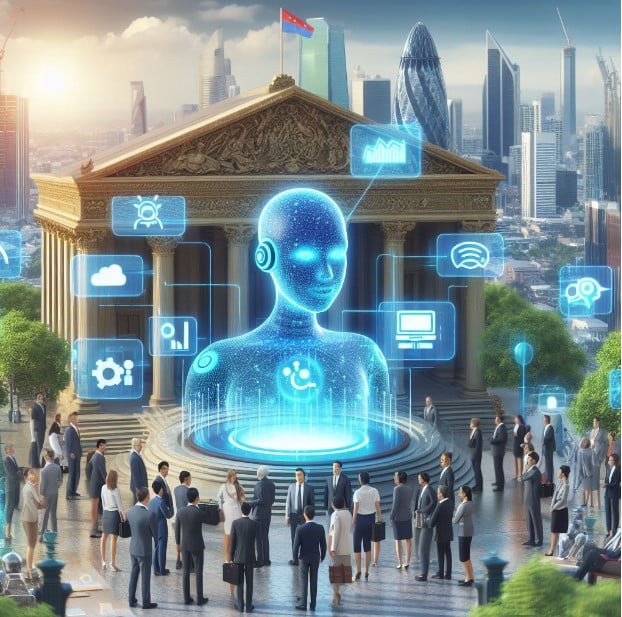Introduction
Artificial intelligence (AI) has rapidly infiltrated our daily lives, influencing everything from how we consume information to how we interact with businesses. This transformative technology is now poised to significantly impact the realm of governance. AI holds immense potential to revolutionise how governments operate, fostering greater efficiency, transparency, and citizen engagement.
A 2018 McKinsey study suggests AI could boost global GDP by 1.2% annually, adding $13 trillion to the global economy by 2030 (Berglind, Niklas, 2022).
AI can seriously improve how things work. It can help governments listen better, spend smarter, and even predict what citizens need before they ask.
For example, AI can analyse social media posts and surveys to understand what’s on people’s minds. This can help leaders make decisions that truly reflect what their citizens want and need. Plus, AI can crunch massive amounts of data to predict traffic jams or school overcrowding. It’s like being able to fix a problem before it even happens!
But hold on a second. Fancy tech doesn’t mean anything if people don’t trust it. That’s why it’s important to make sure AI in government is clear and understandable. People need to know how it works and why it makes its own decisions. With a little transparency, AI can become a powerful tool for making government work better for everyone.
Also, the global AI market for government and public services is expected to grow significantly, reaching $51.78 billion by 2030, up from $20.67 billion in 2023, with a CAGR of 16.9% (Future Data Stats, 2024).
So, let’s explore some of the most exciting use cases of AI in Governance and the Public Sector:
AI For Policy Creation
In governance, biased AI can erode public trust and deepen inequality. Notable failures like predictive policing systems disproportionately targeting minority communities (Douglas, 2020) or biased welfare algorithms unfairly denying benefits (WIRED, 2023) underscore the urgent need for explainable and fair AI to ensure justice, transparency, and equitable treatment in public services.
Crafting effective policies requires understanding the pulse of the public. Traditionally, this involved surveys, focus groups, and public hearings – all time-consuming and limited in scope. But what if we could tap into a vast ocean of public opinion – social media, surveys, economic reports – and analyse it all in real time? AI is here to help.
Harnessing the Power of Public Data
This use case focuses on Natural Language Processing (NLP), a branch of AI that lets computers understand human language. NLP can sift through massive amounts of public data – social media posts, surveys, economic reports – and extract valuable insights using sentiment analysis. Growing concerns about traffic congestion can be identified from citizen tweets or gauging public support for environmental regulations through online surveys.
Tech Solutions for Faster, Smarter Policymaking
Natural Language Processing
Acts as the AI’s translator, breaking down text data into understandable concepts and identifying emotions expressed in public discourse.
Generative AI
This cutting-edge technology takes the insights gleaned by NLP and uses them to generate various policy options that address the identified trends.
The following infographic shows more use cases of Generative AI in the Public Sector:

GPU Acceleration
With enormous datasets involved, processing power is crucial. GPU (Graphics Processing Unit) acceleration provides the horsepower needed to analyse data quickly and efficiently, ensuring policymakers receive timely insights.
AR/VR
Law enforcement can leverage VR simulations for de-escalation training. New recruits practice communication and tactics in safe, virtual scenarios, preparing them for real-world situations.
Transparency: Building Trust in AI-Driven Policy
For AI to be truly transformative, public trust is essential. Here’s how we ensure explainability and verifiability:
Data Source Transparency
Policymakers and the public can see exactly where the data comes from, ensuring a clear picture of the information used to generate policy options.
Explaining NLP Findings
The process of how NLP algorithms identify trends is clearly explained. This showcases the logic behind AI-generated insights and fosters public confidence in the technology.
Human Oversight & Collaboration
The policy options created by AI are not set in stone. Policymakers can review, modify, and refine these options based on their expertise and public feedback. Ultimately, AI empowers human decision-making, not replaces it.
By harnessing the power of AI and public data, we can move towards a future where policies are not just well-informed but truly reflect the needs and concerns of the people they serve.
Predictive Analytics for Resource Allocation

Effective resource allocation is a cornerstone of good governance. However, traditional methods often rely on historical averages or subjective estimates, leading to inefficiencies and potential shortages. AI offers a transformative approach, leveraging predictive analytics to anticipate future needs with greater accuracy and precision.
Forecasting for Informed Decisions
This use case focuses on utilising AI and historical data to forecast resource requirements across various sectors like education, healthcare, and infrastructure.
Predictive analytics algorithms can analyse trends in enrolment figures, patient records, and infrastructure usage, identifying patterns and predicting future demand. This proactive approach allows governments to allocate resources strategically, ensuring they are prepared to meet emerging needs.
Despite being early in digital adoption (80%), a Deloitte report shows strong business leader support (70%) for AI in government. This momentum is expected to translate into widespread hyper-automation initiatives by 2024, with 75% of governments launching such programs (Sajid, 2023).
Tech Stack for Enhanced Efficiency

Predictive Analytics Algorithms
These sophisticated algorithms mine historical data to identify patterns and relationships. This allows them to generate forecasts for various resource requirements, such as the number of teachers needed in a growing school district.
IoT Edge Computing
Sensor networks embedded in buildings and infrastructure can collect real-time data on factors like traffic flow or energy consumption. This continuous stream of data feeds the AI models, ensuring their predictions remain up-to-date and adaptable to changing conditions.
GPU Acceleration
Complex data analysis can be computationally intensive. GPU acceleration provides the processing power required to handle large datasets efficiently, allowing for timely and accurate resource allocation forecasts.
Transparency and Explainability
For AI to be a truly valuable tool in governance, public trust is essential. Here’s how we ensure explainability and verifiability:
Transparent Data Sources
Complete transparency regarding the data used to train the predictive models is crucial. This allows for public scrutiny and ensures confidence in the basis for AI-generated forecasts.
Visualising Predictions
Complex data is translated into clear and concise visualisations. This allows stakeholders to understand the reasoning behind AI’s recommendations and fosters public trust in the technology.
Human Oversight Remains Paramount
AI serves as a powerful tool for prediction, but human expertise remains vital. Government officials can review and adjust AI-generated forecasts based on their experience and contextual understanding, ensuring optimal allocation decisions.
AI-powered Public Interaction and Customer Service

In today’s digital age, citizens expect a seamless and efficient experience when interacting with government services. Limited phone hours and frustrating wait times are no longer acceptable. Artificial intelligence (AI) offers a game-changing solution, transforming how governments connect with citizens and fostering a more approachable and user-friendly experience.
AI Chatbots: 24/7 Service at Your Fingertips
This use case focuses on implementing AI-powered chatbots equipped with NLP capabilities. These chatbots can answer frequently asked questions, schedule appointments, and address basic citizen concerns. NLP allows the chatbots to understand the intent behind user queries, enabling them to provide accurate and relevant information.
An AI chatbot can guide the citizens through the various procedures, answer questions, and even schedule an appointment. This 24/7 availability streamlines citizen service and frees up human agents for more complex interactions.
Exploring the Future of Engagement
While AI chatbots offer significant benefits, they are not a silver bullet. This is where Augmented Reality (AR), Virtual Reality (VR), and Extended Reality (XR) technologies come into play.
AR/VR/XR can create immersive experiences for citizen engagement. The citizens can attend a virtual town hall where they can ask questions directly to local officials in a 3D environment, all from the comfort of their homes.
Building Trust Through Transparency
For AI to be successful in public interaction, transparency is key. Here’s how we ensure explainability and verifiability:
Clearly Defined Limitations
Citizens should be aware of the chatbot’s limitations. Complex inquiries will be seamlessly transferred to human agents for further assistance.
Explanation of Responses
In some cases, chatbots can explain the reasoning behind their responses, fostering user understanding and trust in the technology.
Human Oversight for Critical Matters
Human agents remain central to public interaction. Escalation protocols ensure that complex issues and critical interactions receive the personalised attention they deserve.
Safeguarding Public Programs through AI-Powered Risk Management and Fraud Detection

From social safety nets to healthcare subsidies, government programs provide essential support for millions of citizens. However, these programs can be susceptible to exploitation through activities like identity theft and benefit abuse. AI offers a powerful solution, acting as a vigilant guardian to identify and prevent fraud, ensuring that valuable resources reach those who need them most.
AI for Detecting Fraudulent Activity
This use case focuses on leveraging Computer Vision and Machine Learning algorithms to detect suspicious patterns in government programs. Computer Vision excels at facial recognition and document verification. It is like a system verifying IDs during benefit applications using facial recognition to identify potential identity theft. Machine Learning analyses vast amounts of data to identify anomalies and suspicious patterns. This allows AI to flag potential cases of fraud, such as duplicate applications or irregular activity in benefit usage.
Tech Stack for Enhanced Security
Computer Vision
This technology empowers AI to analyse images and videos, enabling tasks like facial recognition and document verification. In the context of fraud detection, Computer Vision can identify inconsistencies or potential fakes in submitted documentation.
Machine Learning Algorithms
These algorithms can analyse massive datasets and identify patterns that might indicate fraudulent activity. For example, an algorithm might identify unusual spending habits associated with a benefit card, potentially signalling misuse.
GPU Acceleration
Real-time fraud detection is crucial. GPU acceleration provides the processing power needed to analyse data streams efficiently, enabling immediate identification of suspicious activity.
Building Trust through Transparency in AI-powered Security Measures
For AI to be effective in risk management, public trust is paramount. Here’s how we ensure explainability and verifiability:
Clear Data Privacy Guidelines
Governments must establish clear guidelines on data collection, storage, and usage for facial recognition technology. Public awareness of these guidelines fosters trust and transparency.
Human Oversight in Decision-Making
While AI flags suspicious activity, the final decision on fraud rests with human experts. Human oversight ensures a fair and balanced approach, considering context and mitigating potential false positives.
Citizen Communication
Transparency regarding how data is used for fraud detection empowers citizens and builds trust in the system. Clear communication strategies can address concerns and ensure public acceptance of this technology.
What TechnoLynx Can Offer?
At TechnoLynx, we are a leading provider of AI solutions specifically designed for the public sector, with a proven track record in implementing the technologies discussed in this article. Our team of AI experts is dedicated to empowering governments to leverage these technologies for a more effective and efficient public service system.
Our team possesses unmatched expertise in various AI domains, including:
-
NLP to analyse public data and understand citizen needs.
-
Generative AI to create innovative policy options based on real-world insights.
-
Computer Vision for facial recognition and document verification in fraud detection.
-
IoT Edge Computing to collect real-time data from sensors for informed decision-making.
-
AR/VR/XR technologies to create immersive experiences for citizen engagement.
We don’t just offer technology; we offer a comprehensive partnership. We work closely with our partners to understand their unique challenges and tailor AI solutions that deliver measurable results.
Contact TechnoLynx today and discover how AI can do wonders in the field of governance.
Conclusion
AI offers a transformative toolbox for governments, fostering efficiency, transparency, and citizen-centricity. AI empowers data-driven decision-making. However, building public trust is paramount. Governments can ensure responsible implementation by prioritising explainability and verifiability in AI solutions. Ready to embrace AI for a brighter future? Let’s work together to build a more responsive and efficient public service system.
References
-
Berglind, Niklas, et al. “AI in government: Capturing the potential value.” McKinsey & Company, 25 July 2022. Accessed 7 April 2024.
-
Douglas, W. (2020, July 17). Predictive policing algorithms are racist. They need to be dismantled. MIT Technology Review Retrieved August 27, 2024
-
Rajendran, Selvakumar. “Role of AI technology in Government and public sector.” EY.
-
Sajid, Haziqa. “7 Practical Applications of AI in Government.” V7 Labs, 19 January 2023. Accessed 7 April 2024.
-
Stats, Future Data. “AI in Government and Public Services Market Size, Share, Trends & Competitive Analysis Global Report 2023-2030.” LinkedIn, 12 January 2024. Accessed 7 April 2024.
-
WIRED. (2023, March 6). This Algorithm Could Ruin Your Life. WIRED. Retrieved August 27, 2024.













